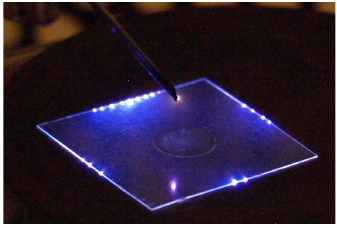
Recovery and resilience plan.


The outer surfaces of long tubes can be easily decontaminated by special arrangement of plasma jets. Only a few studies have dealt with bio-decontamination of the inside of long dielectric tubes by plasma, although lots of devices in medicine have this shape (endoscopes, catheters). Medical endoscopes are the most complex and expensive devices for incorporeal diagnostic and surgery. A treatment with such devices always includes the risk of endoscopic associated nosocomial infections. Therefore the plasma, which can by ignited inside a long dielectric tube, could be a good means of sterilization. Only a handful of laboratories deal with the challenge in decontamination of long narrow tubes.
In collaboration with GeePs Group of electrical engineering - Paris (CentraleSupélec), a discharge propagation length of more than one meter was obtained in a thin (2 mm) inner diameter silicone tube with pure argon flowing at atmospheric pressure. For specific work aimed at the decontamination efficiency evaluation and mechanism investigation, a shorter quartz tube was used. Pulsed corona discharges were propagated on the inner walls of a quartz tube (8 mm inner diameter, variable length) with flowing argon at atmospheric pressure, from a tungsten needle placed at its inlet to a counter electrode located at the tube outlet. Positive high voltage pulses (25 kV peak, 2.2 μs width, 500 Hz) were applied to a tungsten needle electrode placed at the tube inlet. E. coli was used as a model organism for evaluation of bacterial survival in the discharge. Two 10 μl droplets of bacterial suspension were deposited inside the tube at 2 cm and 44 cm distance from the tungsten tip. 20 min exposure time caused reduction of bacterial population in distant location (44 cm) up to 3 logs. Adding a water vapour (720 ppm) to the gas flow caused a significant enhancement of the biocidal activity of the discharge by about 1 log. In argon only flow, we suppose the bactericidal effect is due to the action of excited Ar* and vacuum UV radiation. In argon with water vapor admixture, the formed OH radicals, UV B radiation (OH* emission at 308 nm) and to a lesser extent formed H2O2 contributed to the effect (Kovalova Z. et al., 2013).